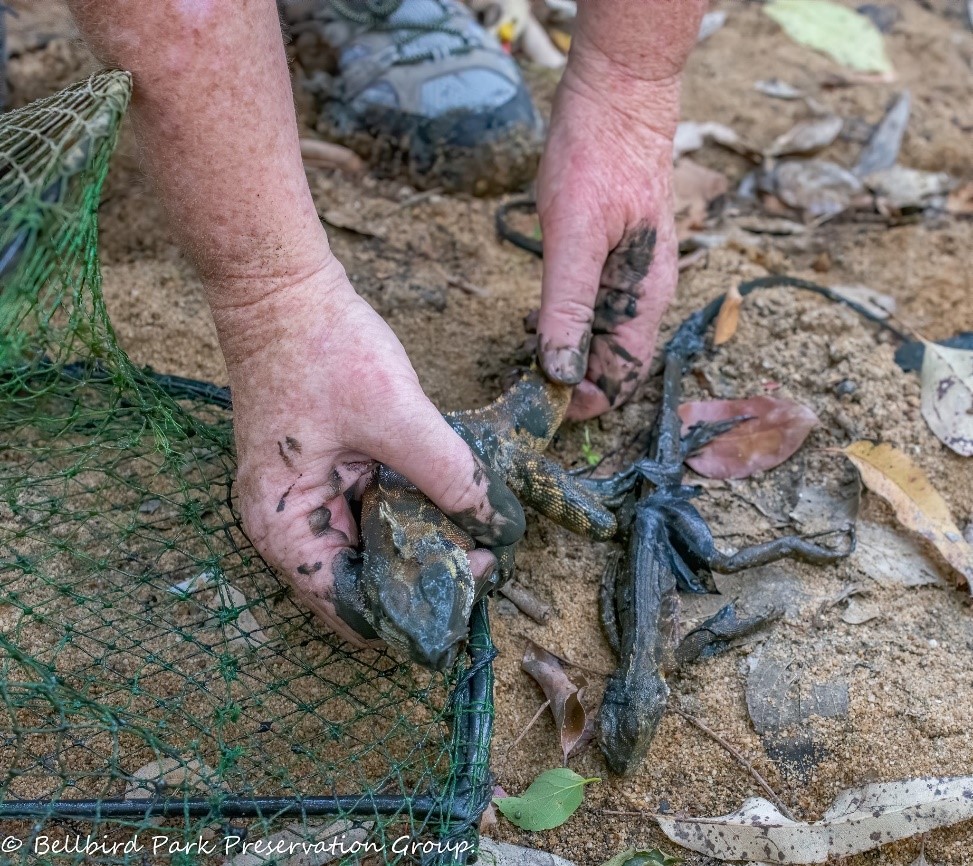21 November 2019
Authors: Tamielle Brunt and Judith Vink

Whilst on a recent walk at Eugene Street Reserve in Bellbird Park, South East Queensland, members of the Bellbird Park Preservation Group retrieved an abandoned enclosed yabby trap (opera house net) from Woogaroo Creek, a known platypus waterway and an important refuge for aquatic wildlife in this time of drought.This is an alarming find in an area that attracts an abundance of aquatic wildlife. These nets indiscriminately trap and drown many air-breathing animals. Not only water dragons but platypus, rakali, turtles and even water birds. The iconic platypus has been detected by environmental DNA (eDNA) methods in this waterway over the past 4 years (see Platypus plotted by DNA) and one has been observed by a local resident earlier this year.
Platypus forage for insect larvae and yabbies along the bottom of a creek. The opera house nets become a baited trap which platypus are attracted to. Once they enter, they cannot find their way out and die a horrific death within minutes.
The regulations for these traps are not promoted or enforced. You can purchase them, cheaply, with no information about laws or animal welfare issues.
In 2015, the Queensland Fisheries Regulation was updated as follows:
“A funnel trap must be no longer than 70 cm or no more than 50 cm in width or height.
The trap entrance must be made of rigid material. If the trap does not have a mesh made of rigid material, the size of the mesh must be no more than 25 mm.”
The use of certain funnel traps east of a line following the Great Dividing Range and east of the Gore Highway (Highway 39) is prohibited outside of certain impoundments (see map).
This means that:
- funnel traps with a rigid opening size of up to 5 cm maximum in all dimensions can be used in all non-tidal waters
- funnel traps with a rigid opening size between 5 cm and 10 cm can only be used in listed impoundments east of a line following the Great Dividing Range and south of the Gore Highway (Highway 39) or in non-tidal waters west of the aforementioned boundary.
Confusing, isn’t it?
Lack of identification or enforcement means no prosecutions!
Even with the entrance holes being reduced to 5 cm, platypuses are smaller in Queensland and when juveniles emerge from the nest in February they can weigh as little as 300 – 400 grams. They (as well as rakali) are small and streamlined and will squeeze through such an opening for a feed.
Wildlife-friendly alternatives
The good news is there are already alternative nets on the market that will capture just as many yabbies without the risk of drowning other air-breathing wildlife. Open top or hoop nets!
This is an animal welfare issue that needs to be addressed in all states. Victoria has led the way, with a swap-out scheme and a complete State-wide ban on these traps in July this year. New South Wales is also following.
It’s time for Queensland to step up and act now, not when it is too late!
We all have the power to make a change and encourage and educate family and friends.
Report sightings and illegal activity
- Report any suspicious or illegal fishing to FishWatch on PH: 1800 017 116.
- Contact the PlatypusWatch Network at platypus@wildlife.org.au or via the PlatypusWatch website with platypus sightings or further information.
About the authors: Tamielle Brunt is a PhD candidate at the University of Queensland, platypus expert and member of the Wildlife Queensland Projects Team. Judith Vink is a PhD candidate in Environmental Science at the University of Queensland and a member of the Bellbird Preservation Group.
More information
- Opera house traps have to go
- Happy Platypus flyer
- Wildlife Queensland’s PlatypusWatch project
